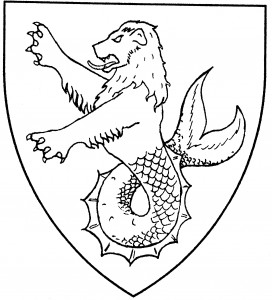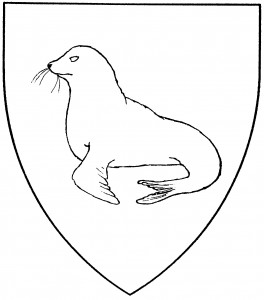The sea-lion is an heraldic sea-monster, with the foreparts of a lion and the tail of a fish; it is also sometimes blazoned a “morse”, especially for canting purposes. It’s found in the attributed arms of “King Palaeologus”, c.1282 [ANA2 493]; in true heraldry, in the arms of Imhof, 1605 [Siebmacher 206].
Period depictions may show the sea-lion with a lion’s clawed forepaws, or with webs between the toes; either form is correct. (The latter is more often found in English emblazons.) There may also be a webbed dorsal fin; this too is artistic license. The sea-lion is erect (rampant) by default, as in the illustration; it may also be found with its tail reflexed over its head, particularly in German armory. The sea-lion’s “proper” tincture is with the leonine portion tawny brown and the piscine portion green.
The modified term “natural sea-lion” refers to the pinniped beast, more often termed a “seal”; the two beasts are heraldically indistinguishable, so the latter term is preferred in blazon. No period heraldic examples of pinnipeds (e.g., seals, walruses, &c) have been cited from period armory, but they are acceptable for Society use. The seal doesn’t seem to have a default posture; the illustration shows a seal sejant.
The Baron of Lyondemere bears: Argent, a sea-lion proper grasping a laurel wreath vert, a base engrailed azure.
Ealasaid Nic Shuibhne bears: Quarterly gules and sable, a sea-lion Or tailed argent.
Anne of Ockham bears: Azure, a sea lion passant, its tail reflexed over its head, within a tressure argent.
Roane Fairegae of Lochlann bears: Argent, on a pile throughout azure a seal haurient argent.

